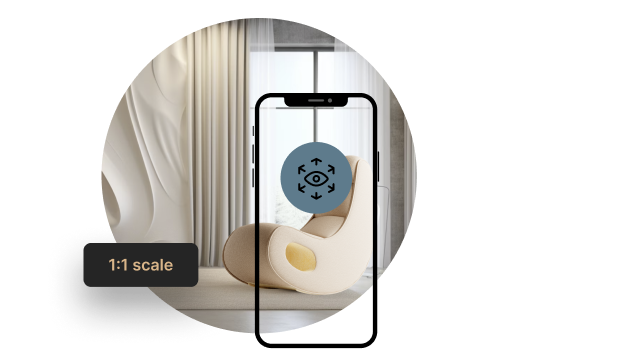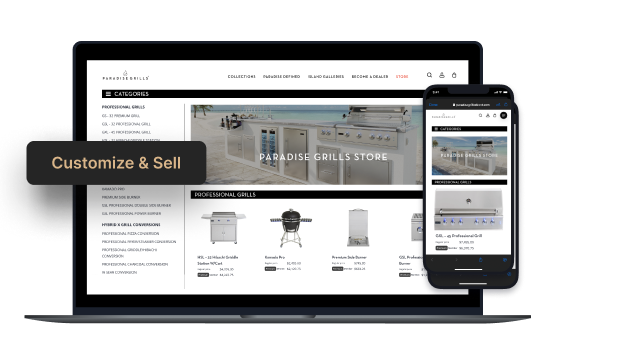The Ultimate 2025 Sofa Configuration Guide
Get your free copy todayy!

Augmented Reality (AR) allows you to display 3D objects on a screen, such as a phone or tablet, by combining digital content with the real-world image presented on the device. For example, you can use your phone screen to visualize a digital dinosaur, an armchair, a plant, or even a packet of crisps right in your living room.
AR technology offers significant opportunities across various sectors, although it was initially used primarily for entertainment. In recent years, it has expanded into industries such as medicine, education, training, e-commerce, and tourism. AR has contributed to business growth globally, benefiting not only giants like Google, Amazon, and Meta but also small and medium-sized enterprises. All you need is creativity, openness, and access to tools or a team that understands AR and knows how to leverage it in business.
In e-commerce, AR is used by companies in industries such as furniture, interior design, cosmetics, construction, FMCG, and automotive. Shopify, an e-commerce sales platform, offers customers the functionality to display products in AR, demonstrating how this once inaccessible technology is now within reach for many entrepreneurs.
Shopify data shows that interactions with products featuring AR have a 94% higher conversion rate than those without AR. The most direct value for customers is the ability to see what a product looks like in 3D at the correct scale and proportion. With AR, users don’t have to guess what the product will look like—they can visualize or even try it on (in the case of furniture or clothing) in the comfort of their home, or wherever they are. This builds confidence in their purchase decisions and reduces the likelihood of returns.
Moreover, AR engages users more deeply with the product. Unlike flat visualizations or photos, AR offers a realistic 3D experience that can be compared only to seeing the product in a store or showroom. In fact, 56% of buyers agree that AR gives them more confidence in the quality of products.
Providing products in AR also creates high-quality and distinctive marketing content, making AR a valuable tool for sales teams. It allows them to display each product variant during meetings with customers or in stores.
Certainly. However, the extent of its use will depend on several factors, including the age of the customers, the ease of using the AR function, and the product itself. According to a 2021 Deloitte Digital study, Gen Z and Millennials are 71% more likely to use AR regularly compared to older generations. Meanwhile, older users are almost 20% more likely to use AR primarily for practical purposes.
An important factor to consider is the change in consumer purchasing habits during the pandemic in 2020 and 2021. Lockdowns forced customers to shift most of their purchases online, increasing openness to technological innovations and trust in using them, including AR.
The key to adoption is how easy it is for customers to use the AR function. The simpler the process, the better. Web-AR, which operates directly in the browser without requiring an external app, is a user-friendly option.
However, implementing AR is just the first step. To ensure your new feature actually boosts conversions, you need to effectively inform customers about it. Dedicated email campaigns or a banner on your store’s homepage can be effective strategies.
Implementing AR on a website is straightforward, with ready-made solutions available for easy integration. Adding AR as a widget is as simple as installing a live chat or callback plugin.
Costs arise primarily if your company lacks 3D models of its products, which are necessary for AR presentations. The cost of creating 3D models varies depending on product complexity but is generally comparable to what you would spend on a photoshoot in a good studio. Once you have 3D assets, you can use them not only for AR but also for content creation, including static visualizations, close-ups, animations, 360-degree views, and configurators.
If you already have a 3D model, the cost of an AR solution for your website will be similar to the license fee for a CRM platform.
Large e-commerce companies like Wayfair and Ikea are heavily investing in their own AR applications. However, for smaller brands, there’s a risk that customers might be deterred from downloading an app just to view product offerings. At Ar-range, we recommend leveraging the potential of web-AR, which operates through a smartphone browser. This solution is more user-friendly and, in most cases, more cost-effective. The function is accessible directly on the website or e-store, allowing customers to visualize the product in AR, at home or in the office, rotate it, adjust it, and then proceed with the purchase.
Web-AR works on all modern iOS devices from iPhone 6 and up (using the ARKit function). iOS-based smartphones with ARKit provide a higher quality AR experience due to the excellent compatibility between software and hardware. Most popular Android-based smartphones (using Google’s ARCore feature) also support AR, and the list of ARCore-compatible devices is expanding daily.
Sources:
https://www.shopify.com/enterprise/augmented-reality-ecommerce-shopping
How AR Is Redefining Retail in the Pandemic (hbr.org)



